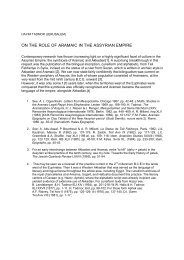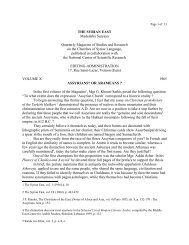The White Syrians Of Aramaean Cappadocia
The White Syrians Of Aramaean Cappadocia
The White Syrians Of Aramaean Cappadocia
Create successful ePaper yourself
Turn your PDF publications into a flip-book with our unique Google optimized e-Paper software.
Assyrians were engaged in the siege of Bactra, which they had long endeavoured in<br />
vain to take. Upon her arrival in the camp, she planned an attack upon the citadel of<br />
the town, mounted the walls with a few brave followers, and obtained possession of<br />
the place. Ninus was so charmed by her bravery and beauty, that he resolved to<br />
make her his wife, whereupon her unfortunate husband put an end to his life. By<br />
Ninus Semiramis had a son, Ninyas, and on the death of Ninus she succeeded him<br />
on the throne. According to another account, Semiramis had obtained from her<br />
husband permission to rule over Asia for five days, and availed herself of this<br />
opportunity to cast the king into a dungeon, or, as is also related, to put him to<br />
death, and thus obtained the sovereign power. (Diod. ii.20; Aelian. V.H. vii.1.)<br />
Her fame threw into the shade that of Ninus; and later ages loved to tell of her<br />
marvellous deeds and her heroic achievements. She built numerous cities and<br />
erected many wonderful buildings; and several of the most extraordinary works in<br />
the East, which were extant in a later age, and the authors of which were unknown,<br />
were ascribed by popular tradition to this queen. In Nineveh she erected a tomb for<br />
her husband, nine stadia high, and ten wide; she built the city of Babylon with all<br />
its wonders, as well as many other towns on the Euphrates and the Tigris, and she<br />
constructed the hanging gardens in Media, of which later writers give us such<br />
strange accounts.<br />
FOOTNOTE: Herodotus only once mentions Semiramis (i.184), where he states<br />
that she was a queen of Babylon, who lived five generations before Nitocris, and<br />
dammed up the Euphrates. As Nitocris probably lived about B.C. 600, it has been<br />
maintained that this Semiramis must be a different person from the Semiramis of<br />
Ctesias. But there is no occasion to suppose two different queens of the name; the<br />
Semiramis of Herodotus is probably as fabulous as that of Ctesias, and merely<br />
arose from the practice we have noticed above, of assigning the great works of the<br />
East of unknown authorship to a queen of this name.<br />
[COMMENT: This is a perfect example of the confusion that Dr. Immanuel<br />
Velikovsky attempted to clear up with his historical reconstruction in the Ages In<br />
Chaos series. <strong>Of</strong> course, there were not two queens named Semiramis. Dr.<br />
Velikovsky equates the Hittites with the Assyrians for many reasons, too complex<br />
to be discussed here. <strong>The</strong>re are numerous Hittite historical sites in <strong>Cappadocia</strong>,<br />
including the legendary Hittite Capital Boghazkoi, the ruins of which are located<br />
north of Tyana and southeast of Ankara. <strong>The</strong> famed aqueduct of Tyana, remnants<br />
of which exist until this day, was said to have been originally constructed by<br />
Hittites, and later repaired by the Romans. <strong>The</strong> mysterious Hittite language was, in<br />
effect, the written language of pre-Aramaic Hittite <strong>Cappadocia</strong>; and its record of<br />
Hittite history is simply a recollection of Assyrian history, written from the<br />
<strong>Cappadocia</strong>n perspective.<br />
[<strong>The</strong> City of Tyana was built by Assyrian Empress Semiramis and <strong>Cappadocia</strong>n-<br />
Hittite King Nimrod in approximately the year 825 BCE. That was only 225 years










